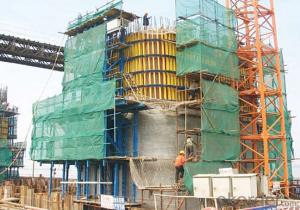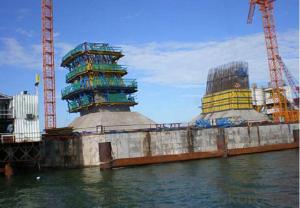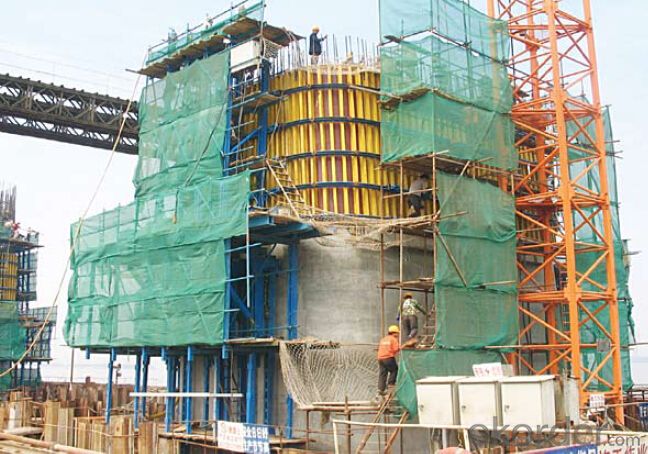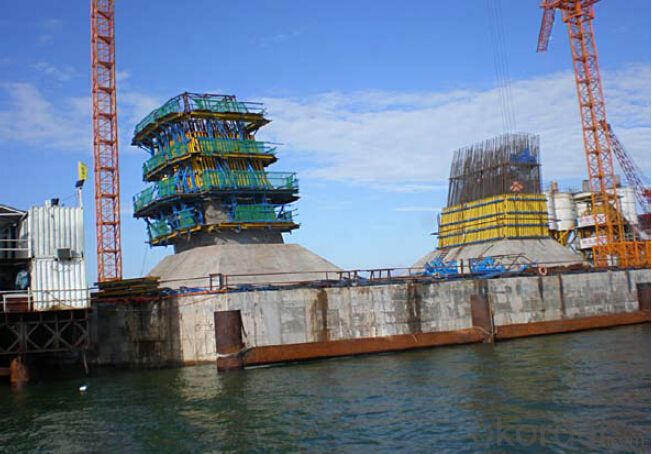Auto-Climbing bracket ACB100 for formwork and scaffolding systems
- Loading Port:
- Tianjin
- Payment Terms:
- TT OR LC
- Min Order Qty:
- 50 m²
- Supply Capability:
- 1000 m²/month
OKorder Service Pledge
OKorder Financial Service
You Might Also Like
Auto-climbing Bracket ACB100 & ACB50
The power of the auto-climbing formwork is the hydraulic system, which includes the oil cylinder
and two commutators. The commutators can control the climbing of climbing rail and the bracket.
The steel rail and the bracket can inter-climbing, so the whole system will climb up steadily.
Cranes are not needed during the construction. It’s easy to operate, highly efficient and safe. It’s
the best choice for the construction of high buildings and bridges.
There are mainly two types of standard auto-climbing brackets, ACB-50 and ACB-100, the figure
means the push power of cylinder with unit of KN.
Characteristics:
◆ Perfect load bearing anchor system
Anchor system is the most important supporting part. The system is made of five parts shown
below. Thereinto, tensile bolt, V-climbing cone and washer can be taken out for reusing after the
concrete pouring finished.There are two kinds of anchor systems,A & B. A is matched with single
anchor shoe and B is matched with double anchor shoe.
◆ Crane-independent
Crane-independent forming, striking and climbing speeds up the work procedures on the
construction site and also makes them independent of each other. This means the planned
sequences can be maintained along with guaranteeing high productivity levels. The crane can
therefore be used for other tasks.
Hydraulic system is mainly made of two commutators,
oil cylinder and power distribution system.The
commutators can control the climbing of climbing rail
and bracket.
◆ High bearing capacity and safe
The stable working platforms are able to carry large loads, e.g. the storage of reinforcing steel
for the next climbing section. Generously-sized working platforms, the well thought-out design for
handling very high wind loads and the patented control function of the climbing mechanism are
some of the special details contained within the comprehensive safety concept.
◆ Platforms adjusted to suit the angle of inclination
The horizontal working areas thus created provide safe and comfortable conditions for
reinforcement work, shuttering and striking, concreting and finishing.
◆ The ACB formwork system can climb not only vertically but also slantways, the largest angle is
18 degrees.
◆ The system can climb up wholly or separately. The climbing process is steady, synchronous
and safe.
◆ The bracket will not fall to the ground until the construction is finished, the field will be saved
and the impacting breakage will be reduced (especially the panel).
◆ The system will furnish omnidirectional platform, the construction organizations don’t need to
set up additional operation platform.
◆ The error of structure construction is small and easy to correct.
◆ The climbing speed is fast, the construction course will be quickened.
◆ The formwork can climb itself and cleaning work can be done in the same situs , the used times
of tower crane will be greatly reduced.

- Q: How does steel formwork affect the overall cost of concrete placement?
- The overall cost of concrete placement can be significantly affected by steel formwork. Although the initial cost of steel formwork may be higher compared to other types of formwork, it offers several advantages that can result in long-term cost savings. To begin with, steel formwork is durable and can be reused multiple times, unlike traditional wooden formwork that often requires replacement after a few uses. This reusability reduces the need to purchase new formwork for each concrete placement, resulting in cost savings over time. Furthermore, steel formwork provides a smooth and consistent finish to the concrete surface, reducing the need for extensive surface preparation and finishing work. This can decrease labor costs and save time during the concrete placement process. Moreover, steel formwork offers better structural stability, ensuring a higher quality concrete placement with minimal defects. This reduces the risk of expensive rework or repairs, thereby saving money in the long term. Additionally, steel formwork allows for a faster construction process due to its easy assembly and disassembly. This can lead to reduced labor costs and increased productivity, ultimately resulting in lower overall construction expenses. Lastly, steel formwork is highly resistant to moisture and weather conditions, reducing the risk of damage and increasing its lifespan. This durability translates to long-term cost savings as frequent replacements or repairs are not necessary. In conclusion, despite the higher initial investment, the durability, reusability, superior finish, structural stability, construction speed, and resistance to damage make steel formwork a cost-effective choice for concrete placement. The long-term savings in labor, materials, and repairs outweigh the initial cost, making steel formwork a wise investment for construction projects.
- Q: Can steel formwork be used for different types of concrete finishes?
- Yes, steel formwork can be used for different types of concrete finishes. Steel formwork is highly versatile and can be customized to create various concrete finishes such as smooth, textured, or patterned surfaces. The steel formwork allows for precise shaping and molding of the concrete, enabling the creation of different finishes according to the desired design and aesthetic requirements. Additionally, steel formwork can be easily adjusted and reused for different projects, making it a cost-effective choice for achieving diverse concrete finishes.
- Q: How does steel formwork affect the overall project budget?
- The overall project budget can be significantly impacted by steel formwork. Although steel formwork may be more expensive initially compared to other types of formwork like timber or plywood, it provides several advantages that can ultimately result in cost savings. Durability is one of the main benefits of steel formwork. Steel is a strong and long-lasting material that can withstand multiple uses without wearing down. This means that steel formwork can be reused for many projects, reducing the need for frequent replacements and lowering long-term costs. In addition, steel formwork allows for faster construction times. Its strength and stability enable contractors to pour concrete more quickly, reducing labor costs and streamlining the construction process. Moreover, steel formwork can be easily put together and taken apart, resulting in shorter intervals between projects. Steel formwork also ensures high-quality concrete structures with precision and consistency. This can minimize the need for rework and corrections, thereby reducing costs associated with fixing errors or imperfections. Furthermore, steel formwork offers design flexibility. It can be customized to fit different shapes and sizes, providing greater architectural freedom and creativity. This versatility can lead to cost savings by eliminating the need for expensive and complex modifications to the formwork system. Lastly, steel formwork is resistant to moisture and weather conditions. Unlike timber or plywood, steel does not warp or deteriorate when exposed to moisture, which can save costs by avoiding replacements or repairs due to water damage. To summarize, although steel formwork may be initially more expensive, its durability, reusability, speed, precision, flexibility, and resistance to environmental factors can result in overall cost savings throughout the project. By considering the long-term benefits and efficiencies offered by steel formwork, project budgets can be effectively managed and optimized.
- Q: Can steel formwork be used for complex geometric shapes?
- Complex geometric shapes can indeed be created using steel formwork. Steel, being an incredibly versatile and malleable material, can easily be molded and shaped to fulfill the demands of various intricate designs. Its outstanding strength and durability make it ideal for constructing formwork for elaborate architectural and structural shapes. With steel formwork, it is possible to fabricate and tailor the angles, curves, and dimensions precisely, enabling the realization of intricate and distinctive shapes in construction projects. Moreover, steel formwork can be reused numerous times, making it a cost-effective choice for projects that necessitate complex geometric shapes. All in all, steel formwork offers the essential flexibility, strength, and durability needed to effectively accommodate complex architectural and structural designs.
- Q: Can steel formwork be used for structures with complex geometries?
- Yes, steel formwork can be used for structures with complex geometries. Steel formwork is highly versatile and can be easily customized to match the specific shape and dimensions of the structure. It is known for its strength, durability, and flexibility, making it suitable for constructing structures with intricate designs and complex geometries. Steel formwork systems can be adjusted, assembled, and disassembled according to the required shape, allowing for the creation of unique architectural elements and complex structural configurations. Additionally, steel formwork provides a smooth and precise finish, ensuring the accuracy and quality of the final structure. Overall, steel formwork is a reliable and efficient option for constructing structures with complex geometries.
- Q: Are there any specific considerations for using steel formwork in areas with high traffic loads?
- Yes, when using steel formwork in areas with high traffic loads, it is important to consider the strength and durability of the steel to ensure it can withstand the heavy loads. Additionally, proper reinforcement and support systems should be in place to distribute the weight evenly and prevent any deformation or structural failures. Regular inspections and maintenance are also crucial to identify and address any potential issues that may arise due to the high traffic loads.
- Q: Can steel formwork be used for projects with complex geometries?
- Yes, steel formwork can be used for projects with complex geometries. Steel formwork offers high strength and durability, which makes it suitable for handling complex shapes and intricate designs. Steel formwork can be easily fabricated and customized to meet the specific requirements of the project, allowing for the creation of complex geometries without compromising on structural integrity. Additionally, steel formwork provides excellent dimensional stability, ensuring precise and accurate construction of complex shapes. The versatility and flexibility of steel formwork make it a preferred choice for projects that involve intricate and complex geometries.
- Q: How does steel formwork affect the overall maintenance requirements of the structure?
- The overall maintenance requirements of a structure can be significantly impacted by the use of steel formwork. One of the main advantages of steel formwork is its durability and long lifespan. Unlike traditional timber formwork, steel formwork is more resistant to wear and tear, weather conditions, and insect infestation. As a result, structures built with steel formwork require less maintenance over time. Moreover, steel formwork provides a smooth and even surface finish, reducing the need for extensive repair and maintenance work. This is particularly important for structures that require a high level of accuracy and precision, such as tall buildings or bridges. By using steel formwork, the structure is constructed with minimal imperfections, thus reducing the need for costly and time-consuming maintenance in the future. Additionally, steel formwork is designed to be reusable, which can greatly reduce maintenance costs. Once the concrete has set, the steel formwork can be easily dismantled and utilized for other construction projects. This not only saves money but also reduces waste, making steel formwork a more sustainable option. However, it is crucial to note that proper cleaning and maintenance of steel formwork are necessary after each use to ensure its effectiveness and longevity. Regular inspections and maintenance checks should be carried out to identify any signs of damage or deterioration. Prompt repairs or replacements should be executed to prevent further issues. In conclusion, the use of steel formwork can significantly decrease the overall maintenance requirements of a structure. Its durability, resistance to damage, and reusability make it an economical and low-maintenance choice. Nevertheless, proper cleaning, maintenance, and periodic inspections are still essential to ensure optimal performance and longevity.
- Q: How does steel formwork handle different concrete water-cement ratio specifications?
- Steel formwork is highly adaptable and can easily handle different concrete water-cement ratio specifications. The strength and durability of steel allow it to withstand the pressures exerted by varying water-cement ratios during the concrete pouring process. Additionally, steel formwork provides a smooth and even surface, ensuring proper consolidation of the concrete, regardless of the water-cement ratio used.
- Q: Can steel formwork be used for precast concrete columns?
- Yes, steel formwork can be used for precast concrete columns. Steel formwork offers durability and strength, making it suitable for creating precise and complex shapes required for precast concrete columns. Additionally, steel formwork can be reused multiple times, making it a cost-effective option for precast concrete column production.
Send your message to us
Auto-Climbing bracket ACB100 for formwork and scaffolding systems
- Loading Port:
- Tianjin
- Payment Terms:
- TT OR LC
- Min Order Qty:
- 50 m²
- Supply Capability:
- 1000 m²/month
OKorder Service Pledge
OKorder Financial Service
Similar products
Hot products
Hot Searches


















